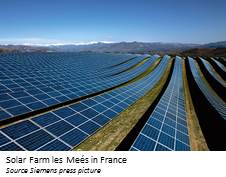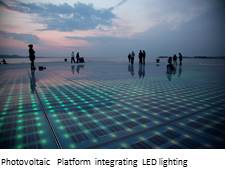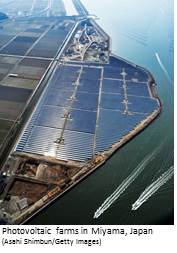Different BIPV perspectives (part II) :landscape, building-integrated photovoltaics and performance modelling
This SOPHi@webinar event is based as the previous one, on three presentations already offered during 2nd SOPHIA BIPV workshop and it will further deepen on PV landscape, vertical Façade integration and energy performance modelling

Useful information
The fast decrease of photovoltaic (PV) system prizes and at the same time the need to provide energy for new low- and plus- energybuildings and to develop net zero energy communities offer the opportunity to the designer of envisioning the use of  photovoltaic at both architectural (building integrated photovoltaic) and landscape scale level. The realization of successful pilot plants well integrated mainly in building than on the ground and the cost benefit coming by substituting functions of other building components by fulfilling multiple requirements, i.e. being multifuntional , is the more convincing showcase to demonstrate the powerfulness and adaptability of BIPV . This short workshop will give an overview on the land use and the transformation of building to integrate photovoltaics, will propose the fundamentals on the architectural
photovoltaic at both architectural (building integrated photovoltaic) and landscape scale level. The realization of successful pilot plants well integrated mainly in building than on the ground and the cost benefit coming by substituting functions of other building components by fulfilling multiple requirements, i.e. being multifuntional , is the more convincing showcase to demonstrate the powerfulness and adaptability of BIPV . This short workshop will give an overview on the land use and the transformation of building to integrate photovoltaics, will propose the fundamentals on the architectural design and an overview of the more successful application in Europe and Japan, and it will discuss the best practice examples of integrated façade system .FFurther, quality issues and test procedures in order to guarantee will be addressed. Last but not last, BIPV systems operate with lower irradiance and with higher temperatures (especially warm facades) and datasheet specifications of PV modules often refer to standard test conditions (STC) only. The last speech will shows some mathematical improvements that lead to a complete evaluation of I-V performance of BIPV systems
design and an overview of the more successful application in Europe and Japan, and it will discuss the best practice examples of integrated façade system .FFurther, quality issues and test procedures in order to guarantee will be addressed. Last but not last, BIPV systems operate with lower irradiance and with higher temperatures (especially warm facades) and datasheet specifications of PV modules often refer to standard test conditions (STC) only. The last speech will shows some mathematical improvements that lead to a complete evaluation of I-V performance of BIPV systems
Agenda
Details
Photovoltaic Systems: Architecture and Landscape design issues
Speakers : SCOGNAMIGLIO Alessandra
The target of running the places we inhabit by using only renewable energy generation technologies (net zero energy buildings, net zero energy communities) challenge us to find ways how to give them a form. Whatever the device we think to use, it has a certain form, that will influence the way we will design it, or, at the end of the process, the shape of our living environment.
 Thanks to their features, photovoltaic system offer the designer the possibility of envisioning the use of photovoltaic at the architectural scale (building integrated photovoltaic), as well as at the landscape scale.
Thanks to their features, photovoltaic system offer the designer the possibility of envisioning the use of photovoltaic at the architectural scale (building integrated photovoltaic), as well as at the landscape scale.
Different technological and design issues are related to these uses of photovoltaic.
In the first case, photovoltaic components are used as parts of the building envelopes, and this implies a relevant importance in developing special BIPV technological elements, which could ensure the desired building performances; or in finding appropriate solutions in order to use standard components on the envelope, in an innovative way. 
This topic has been largely investigated in the past 20-25 years, and the tutorial will give an overview on the general topic of the building integration of photovoltaic, and on the design fundamentals.
In the second case, photovoltaic modules are arranged in the form of solar arrays, without exploiting any other function than generating energy.
They can be understood as a tangible image of an increasing need of energy from renewables to significantly reduce the pollution caused by traditional energy generation systems, but anyway they generate a diffuse concern about the land use and transformation that they cause. PV and crops are kinds of opposing needs that should share the same limited resource: the land.
Because of this reason in many countries local authorities prohibited the installation of PV in agricultural areas; and due to this barrier, in recent years companies working in the PV development have been experimenting with solutions for producing energy and food in the same land area. Such experiences will be presented and the issue of PV power generation will be addressed from the landscape design point of view (PV landscapes).
no download available.
Recent BIPV Situation in Japan
Speakers : SAITO Hiroko
PVTEC (Photovolt aic Power Generation Technology Research Association) launched BIPV research activities cooperation with various sectors persons.
aic Power Generation Technology Research Association) launched BIPV research activities cooperation with various sectors persons.
The speech is based on 1st BIPV workshop held in April 2014 Japan and organized by PVTEC with four invited speakers of three module manufacturers and a building designer. Forty attendees from both PV and construction industry discussed with the speakers on requirements and issues of BIPV standards, market etc.
Speech will report background and motivation of the workshop, discussion summary and introduction of actual BIPV installation market in Japan. Additionally effort for international standardization in Japan will be reported
(note this speech originally planned on Jan12-2015 has been postponed to Jan. 29-2015)
no download available.
Multifunctional integration of vertical BIPV
Speakers : RENNHOFER Marcus
The fully building integrated implementation of photovoltaic in building envelopes (BIPV) has been done for a few decades. It then was a matter of showcases and demonstration of the powerfulness and adaptability of BIPV components. Now the fast decrease of photovoltaic (PV) system prizes and at the same time the need to provide energy for new low-energy buildings or plus-energy buildings, districts or cities leads to new ways of thinking. PV can be affordable in buildings and even of a cost benefit by substituting functions of other building components which may then be spared. Further PV can allow to decrease the number of building components and maintenance costs and failure number when used in a way of fulfilling multiple requirements, i.e. being multifunctional. Especially the façade of buildings is an unused area by which building comfort and energy requirements may fulfilled by BIPV components. In this work some of the most essential functions are shortly discussed and presented by the means of a best practice example of a test façade system. Further, quality issues and test procedures in order to guarantee these will be addressed.
no download available.
IV curve modelling for wafer-based PV technologies
Speakers : SPRENGER Wendelin
Datasheet specifications of PV modules often refer to standard test conditions (STC) only. For BIPV, the operating conditions are even farer away from STC than free-standing PV plants. In general, BIPV systems operate with lower irradiance and with higher temperatures (espeically warm facades). For this reason, the calculation of the electrical properties for these operating conditions from the STC specifications is more critical for BIPV than for standard PV applications. In literature, the so-called two-diode model has been established since decades, and many different versions of the two-diode model exist. Recent publications (Hofmann 2012, Elies 2008) have shown that there are still possibilities of improving the model. The speech shows some mathematical improvements that lead to a complete dataset of two-diode parameters with only the datasheet specifications used.
no download available.
